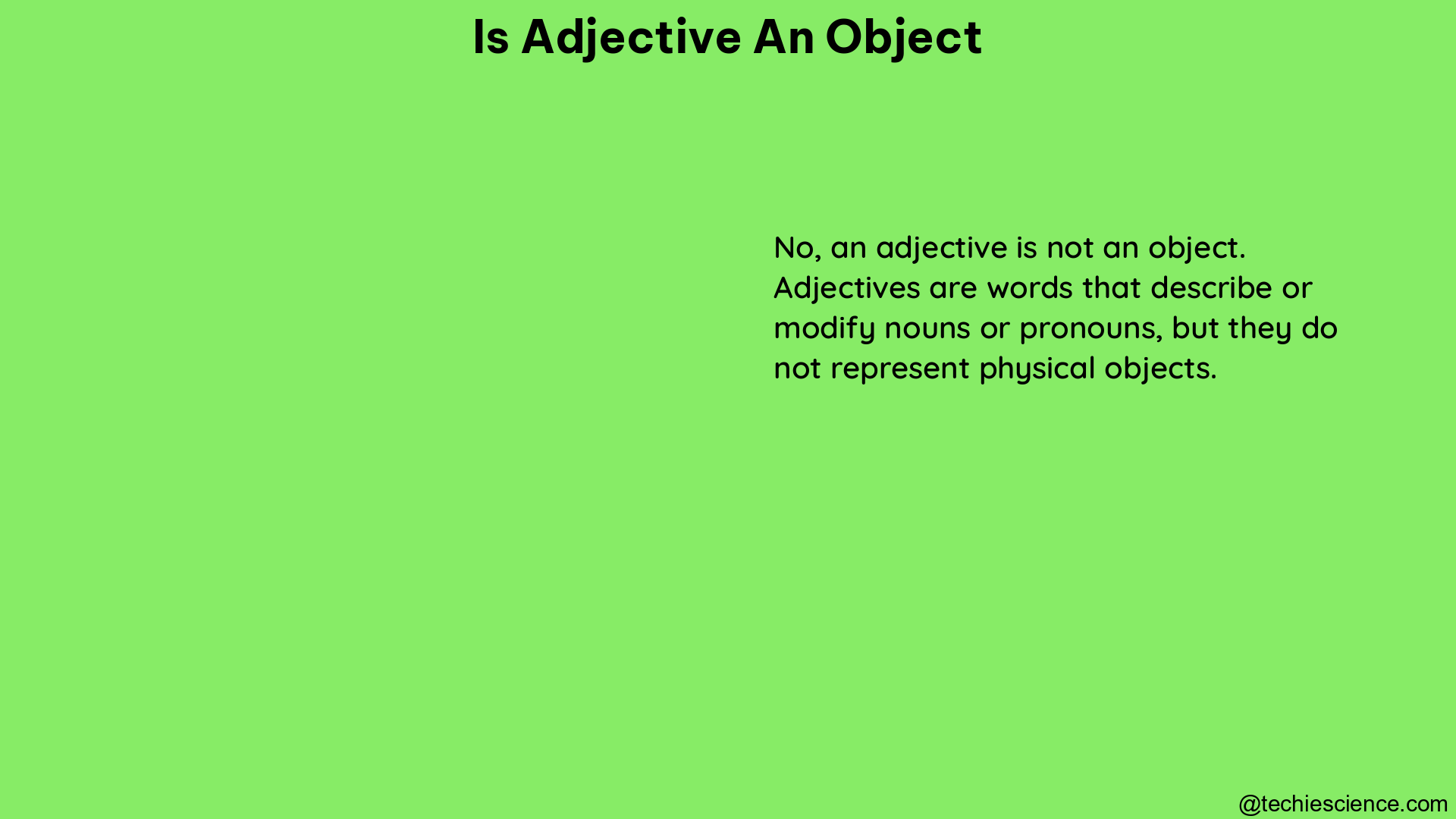An adjective is a part of speech that modifies or describes a noun or pronoun, providing additional information about its characteristics, qualities, or state. On the other hand, an object is a noun or noun phrase that receives the action of a transitive verb. While both adjectives and objects play important roles in sentence structure, they are distinct grammatical elements with different functions.
Understanding Adjectives
Adjectives are words that describe or provide more information about a noun. They can answer questions like “What kind?”, “How many?”, “Which one?”, or “Whose?”. Adjectives can be placed before or after the noun they modify, depending on the language and grammatical structure.
Types of Adjectives
Adjectives can be classified into several categories based on their function and meaning:
- Descriptive Adjectives: These adjectives describe the physical or emotional qualities of a noun, such as “big,” “red,” “happy,” or “intelligent.”
- Quantitative Adjectives: These adjectives indicate the amount or number of a noun, such as “many,” “few,” “several,” or “some.”
- Possessive Adjectives: These adjectives indicate ownership or possession, such as “my,” “your,” “his,” or “their.”
- Demonstrative Adjectives: These adjectives point out or identify a specific noun, such as “this,” “that,” “these,” or “those.”
- Interrogative Adjectives: These adjectives are used to ask questions about a noun, such as “which,” “what,” or “whose.”
Adjective Placement
The placement of adjectives in a sentence can vary depending on the language and grammatical structure. In English, adjectives are typically placed before the noun they modify, as in “the beautiful flower” or “a large house.” However, in some cases, adjectives can also be placed after the noun, as in “the flower is beautiful” or “the house is large.”
Understanding Objects

An object is a noun or noun phrase that receives the action of a transitive verb. Transitive verbs are verbs that require an object to complete their meaning, such as “eat,” “see,” or “write.” The object is the entity that the verb acts upon.
Types of Objects
There are several types of objects in English grammar:
- Direct Object: The direct object is the noun or noun phrase that directly receives the action of the verb, as in “I ate an apple” (where “apple” is the direct object).
- Indirect Object: The indirect object is the noun or noun phrase that indirectly receives the action of the verb, as in “I gave the book to my friend” (where “my friend” is the indirect object).
- Prepositional Object: The prepositional object is the noun or noun phrase that follows a preposition, as in “I walked through the park” (where “the park” is the prepositional object).
Object Placement
In English, the object typically follows the verb in a sentence, as in “I read a book” or “She wrote a letter.” However, the placement of the object can vary depending on the sentence structure and the type of object (direct, indirect, or prepositional).
Differences between Adjectives and Objects
The key differences between adjectives and objects are:
- Function: Adjectives modify or describe nouns, while objects receive the action of a transitive verb.
- Position: Adjectives are typically placed before the noun they modify, while objects follow the verb in a sentence.
- Grammatical Role: Adjectives provide additional information about a noun, while objects are the entities that verbs act upon.
- Types: Adjectives can be classified into various categories (descriptive, quantitative, possessive, etc.), while objects can be direct, indirect, or prepositional.
Examples
- Adjective Example: “The tall tree” – In this sentence, “tall” is an adjective that describes the noun “tree.”
- Object Example: “I ate an apple” – In this sentence, “apple” is the direct object that receives the action of the verb “ate.”
- Combination Example: “The big dog chased the small cat” – In this sentence, “big” and “small” are adjectives that describe the nouns “dog” and “cat,” respectively, while “cat” is the direct object that receives the action of the verb “chased.”
Conclusion
In summary, while adjectives and objects are both important elements in sentence structure, they serve distinct grammatical functions. Adjectives provide additional information about nouns, while objects are the entities that verbs act upon. Understanding the differences between these two concepts is crucial for effective communication and proper sentence construction.
Reference:
- https://www.italki.com/en/post/gXouKQt966nC9UIZ74ctYf
- https://www.merriam-webster.com/dictionary/object
- https://dictionary.cambridge.org/us/grammar/british-grammar/objects
Hey! I am Arpita Bose Roy. My qualifications are M.A. in English with B. Ed. in both general education and special education. I have 2 years of experience as a “language analyst” at IIT Kharagpur and 4 years of experience as an “Academic Content Developer” at IIT Kharagpur. Currently, I am working as an academic writer at Lambdageeks.